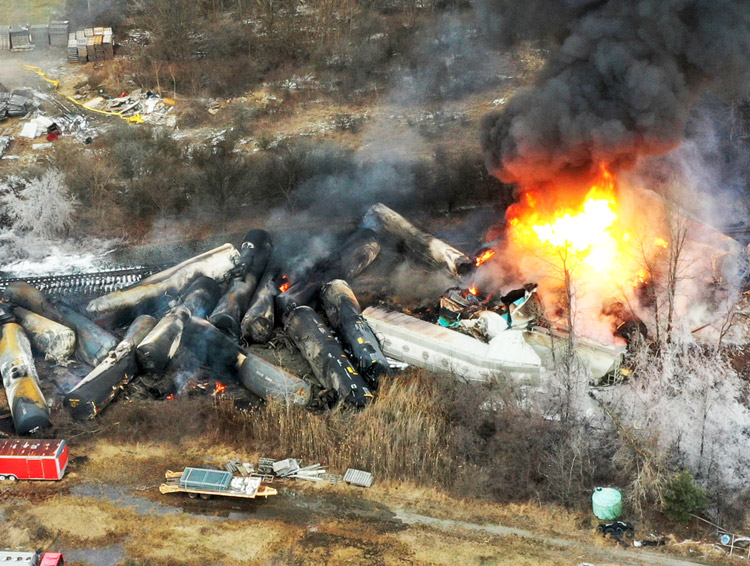LINCOLN, Neb. — The rail bosses and the wealthy capitalist investors that share in the profits from their operations are determined to keep raking in money off the back of rail workers. Over the last four decades, they have pursued a relentless drive to cut crew sizes on freight trains and yard switching operations down to two — and sometimes to only one worker.
When crew sizes are cut, it increases the workload on the remaining workers, resulting in increasingly unsafe conditions and more hazards for people living and working near rail tracks.
It also means new workers have less opportunities to learn from experienced co-workers, in a job that takes years to conquer.
The rail bosses count on bipartisan support from the government — the politicians, courts, arbitration boards and a myriad of other regulatory bodies. Only the mobilization of union power and solidarity in action can push back the bosses’ offensive.
The latest attack is at the BNSF Railway. It was the last of the six Class I railroads where union contracts still required a third crew member — a helper or brakeman — on most yard, industry and local switching jobs.
That’s why a large majority of SMART-TD union members at BNSF voted in October to reject a tentative crew consist agreement that would allow bosses to eliminate the helper and brakeman jobs. Hoping to influence the vote, the company offered a $27,500 “signing bonus,” some extra pay and a promise that current employees wouldn’t be laid off.
BNSF, owned by multibillionaire Warren Buffet’s Berkshire Hathaway conglomerate, has been pushing since 2019 to catch up with its competitors in cutting jobs. In 2021 the company won an arbitration ruling to force SMART-TD to negotiate the “crew consist” issue. Arbitration boards were established under the Railway Labor Act, a notorious anti-labor law passed by Congress in 1926. It ties up railroad, and now airline, workers in a complex and yearslong series of negotiations, “cooling-off” periods and arbitration, a setup that is stacked against workers and their unions.
And, if after years workers finally are allowed to strike, the president can shove the contract they rejected down their throat and order them back to work — as Joseph Biden did in 2022.
Gov’t approves bosses’ demands
After SMART-TD rejected BNSF’s offer, union officials agreed to send the issue to binding arbitration. They argued it was better to do so rapidly, before the Donald Trump administration took office.
Within weeks the arbitration board ruled the bosses’ “tentative agreement is fair and reasonable,” and imposed exactly what the big majority of rail workers had rejected. To add insult to injury, they cut the “signing bonus” by $500, to account for “additional costs incurred by BNSF.”
After the ruling, BNSF began the first round of job cuts across its 28-state network.
The ruling “is almost identical to the one that union members who work for BNSF voted down,” Andrew Foust, Nebraska state legislative director for SMART-TD, told the Cowboy State Daily, Wyoming’s largest newspaper. He explained the cuts will leave crews that are already stretched thin even thinner.

Foust worked for the railroad for 20 years, and said he “can’t even imagine now walking an entire train, out there switching in the middle of the night by myself.” There’s “no one out there with me and the nearest member of my crew being a mile and a half away.”
“Railroad bosses have been on a drive to cut back train crews for over four decades. When my dad was a conductor, a train crew had five workers,” Lance Anton, a SMART-TD conductor with 14 years’ experience in Lincoln, told the Militant. “Crew consist” agreements are elimination of workers and greater profits for the railroad owners and stockholders.
“Smaller train crews lead to dangerous conditions for the workforce and the communities that trains pass through, and we’ll end up having more East Palestine-type disasters,” he said. “Our railroad unions need to organize and fight for 50-car trains and a crew of four, two on the locomotive head end and two riding in a locomotive on the rear of the train.”
In mid-January BNSF arbitrarily and with no notice to the union further tightened its already draconian attendance policy for train crew members. Anton said, “Now there’s even less breathing room to have time off for the family.”
Bosses push cuts, higher profits
Like BNSF, bosses at other Class I railroads are on the prod against the rail unions. Union Pacific is turning over operation of its yard in Eugene, Oregon, to the Central Oregon & Pacific Railroad, a short line owned by Genesee & Wyoming. The union says this will result in 30 to 40 jobs being cut. Central Oregon & Pacific Railroad says displaced workers can apply to work at the short line, but there is no union and pay rates are lower.
For decades, the Class I railroads have been abandoning or selling off rail yards and spurs to operators like Genesee & Wyoming, with the aim of cutting jobs and wages and weakening the unions. Today short lines operate 50,000 miles of track, nearly 40% of the country’s rail network. Genesee & Wyoming is North America’s largest short line holding company, running more than 100 rail lines in the U.S. and Canada, as well as operations in the U.K.
The only way for workers to push back against these attacks is using union power, and the widespread solidarity we can win when we fight. A good sign of workers’ desire to fight was the recent unanimous vote by workers at Wilmington Terminal Railroad, a subsidiary of Genesee & Wyoming in North Carolina, to join SMART-TD.
The broader upturn in labor resistance in the U.S. means it’s a good time for rail workers to speak out and organize against bosses’ attacks. We’ve seen strikes by longshore workers, autoworkers and hotel workers win important gains. Airline flight attendants, who also face Railway Labor Act restrictions on their right to strike, have organized picket lines and rallies to draw attention to their fight.
Joe Swanson is a retired rail worker. Naomi Craine is a member of SMART-TD in Chicago.


